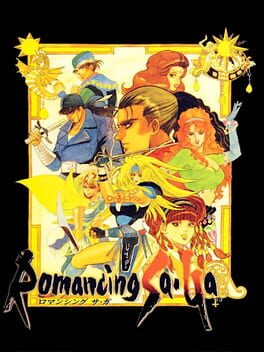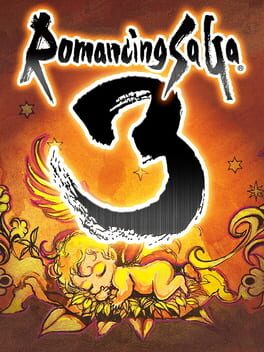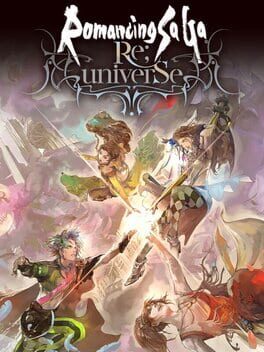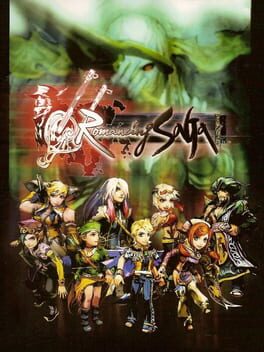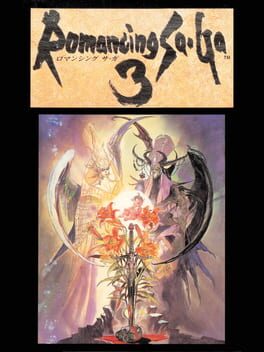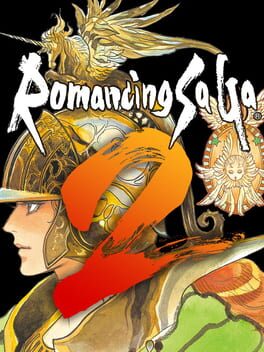

A thousand years ago, Saruin was imprisoned. Now the barriers that contain him are weakening, and his foreboding shadow threatens to swallow the world of Mardias once again. Who will rid the world of Saruin's scourge? A mysterious minstrel appears and guides the group to adventure, at times shielding them from adversity. Occasionally, the minstrel forces grave choices upon them, which change their world and twist the plots they encounter. Romancing SaGa reclaims the renowned features of the series and boasts all new elements enhancing gameplay, bringing the player even deeper into the story. The free-roaming scenario system gives gamers a choice of eight intriguing playable characters, each with their own unique adventures and individual goals. Depending on the character and actions chosen, the plot and the subsequent events differentiate dramatically. This free-roaming scenario system promises the ultimate in open-ended adventure.
Also in series
Reviews View More
As the opening cutscene explains, long, long ago, there was nothing but darkness and turmoil in the world. The three gods of death let havoc reign, and life was nearly impossible. That is until one day, the father of all gods, Elore, put a stop to it. Wielding the power of the ten destiny stones, his chosen human heroes forced the gods of death to stand down, and peace to come to the world for the first time. However, one god of death did not back down. Saruin, the strongest of them, refused to surrender, and only at the end of a long, bloody battle was he finally sealed away, though it came at the cost of the life of Elore’s chosen champion of men.
That’s really all you get to set the stage for the very interesting and unconventional story that is the first Romancing SaGa. Though its graphics make it feel like a rom-hack of Final Fantasy IV, the actual gameplay and narrative design of Romancing SaGa is incredibly ambitious and unique for the January of ‘92 (at least on consoles, anyhow). You have your choice of eight different potential starting characters, and after naming them, you drop into their story. A brief introduction to their tale will see you (usually) set on a brief opening quest that shows how they start adventuring around the land, but there isn’t much in the realm of “plot” to Romancing SaGa 1, at least not in the traditional sense.
Trading more traditional narrative design elements (or at least their execution) for freedom of choice, the “Free Scenario” system means that you can, and are encouraged to, play Romancing SaGa however you want, really. If you want to explore a location, go there! If you want to recruit a party member, do it! There’s even a sort of in-built morality system, and certain quests and events will happen differently depending on how you’ve led your life on your adventure up until this point. While there are certainly quests and bits of story here and there, it’s almost all entirely optional save for your opening quest and however you end up learning of where the final boss is hiding. I started as the pirate captain Hawk, and after being betrayed and cast out of Pirate’s Coast with his first mate Geraha the lizardman, we traveled the land fighting monsters, hunting for treasure, and righting wrongs where we could. But a lot of that adventure happened just because of where I happened to be at particular times and who happened to be with me. The narrative design of Romancing SaGa 1 allows for a really impressive amount of emergent storytelling for the time, and even though it might not be everyone’s cup of tea, it was a really cool experience that is certainly something novel in the SFC’s early library.
The way that Romancing SaGa 1 achieves this degree of freedom and world progression is by something the Event Rank system (or at least it was called that by the time of the PS2 remake). After every battle you fight, the world’s event rank will tick up by one point, and once the event rank gets high enough, certain things start to occur. Higher rank quests will open up, lower rank quests will go away and/or auto-fail, and the monsters of the world will gradually be replaced with stronger replacements as the world ticks ever closer to Saruin’s resurrection (which happens at about 880 battles, for those curious).
This is both a strength and a weakness of the game’s design depending on what kind of experience you’re looking for. If you’re looking for emergent gameplay and carving out your own adventure regardless of what happens, then you’re likely going to like the Event Rank system quite a bit. However, if you’re the type of player who MUST see everything in one playthrough and really hate missing out on ANYTHING, no matter how trivial, then this is likely going to drive you crazy and make you have a miserable time. It’s up to you which one of those you’ll end up being, but I’ll end my explanation of the Event Rank system with a bit of advice I found on a Japanese guide site when I was looking for advice just starting out. This game lets you have any kind of adventure you want. Instead of worrying about what you’re missing, before you start looking up any more detailed guide or what not, just do your best to lose yourself in the adventure, and follow fate’s thread wherever it leads you. It’s what the game was specifically designed for, and you’ll end up having a much better time if you play it that way. This is how I approached the game, and I can say without a doubt that it made my time with it far, far better as a result~.
Being a SaGa game, the actual RPG mechanics of it are certainly unconventional, but I honestly found them to be quite straightforward and simple once I had the hang of them. It may seems strange at first to have no world map in a game from this era, just picking a new spot on the map to go to once you’ve learned about it in game will become second nature to you very quickly. It will get you in the habit of talking to everyone you see, which will not only help you unlock new areas, but it will also help you bump into new quests much easier too~.
While we’ve thankfully discarded the weapon durability system that the GameBoy SaGa games love so much, we’ve expanded the way that Espers would randomly gain stats to a much larger gameplay system. While your party of six will indeed have chances to gain weapons on their respective levels and spells only when they’ve used that particular weapon or kind of spell in battle, all of their other stats simply have a random chance of leveling up at the end of each turn-based encounter. Depending on the background you give your character at the start, there are some slight leveling biases for different characters and backgrounds, but there is generally nothing one character can do that another can’t. While it’ll certainly take a fair bit of time (time you don’t have, since you have that event rank to worry about) to re-spec someone very skilled with an iron sword to start being a back-row magic user, there’s nothing actually stopping them from doing that and getting good at it just like a caster who’s been doing it since the start of the game.
This all amounts to a gameplay experience that is very flexible towards adapting to how you want to play the game. If you’re being conscious of your event rank, of course, there are certainly some best practices to follow, though. Weapon skill level often matters a lot more than your character stats (and stats don’t affect bow damage at all), so sticking with one weapon for a very long time is a really smart and good way to play the game, because even just unequipping a weapon (of which you can eqiup like six at a time) will reset your skill level on it. Armor and defense are VERY important, as this is largely a game of rocket tag. Tanking an enemy hit and then attacking back hard enough that they go down in one or two turns is the recipe for winning most tough encounters, so prioritizing armor over weapons is a very smart strategy. Party members are largely interchangable outside of certain quests that are tied to particular ones, so using someone for whatever role you may need them to fill at the time is a perfectly fine solution, and you don’t need to hunt around everywhere looking for a perfect fit if all you need is a warm body to sling spells and wield a bow.
A lot of the freedom in this game can seem extremely foreboding, and I wouldn’t blame anyone for feeling that way, but what makes that MUCH easier to deal with (especially compared to the PS2 remake) is that this game is ultimately just not very difficult. As long as you’re following best practices and not just playing badly, you don’t need to play anywhere remotely close to “optimally” to actually have a fun time and have a chance at beating the game. You actually have all the time in the world to go to the final dungeon in the end, so grinding up at the end of the game until you’ve got the best weapons and armor money can buy is a pretty smart idea once you’re there (and it’ll be a fair bit of grinding, admittedly), but it’s very easy to have a fulfilling and fun adventure just like I did without needing to have a character building walkthrough open the entire time.
A guide can be helpful to point you towards those best practices I mentioned and help poke you in the right direction for a quest, sure, but there is absolutely no need to let the freedom of the game stand as an obstacle in enjoying your adventure. The degree to which you can experiment and party build is intimidating, no doubt, but the game does a really good job at setting you up for success to the point that just wandering wherever the wind takes you is still a perfectly valid and fun way to enjoy your adventure without feeling like you’ve created a part that can’t possibly complete the game.
The presentation of the game is quite nice, but it’s still an early-life SFC RPG at the end of the day. The music is just the quality you’d expect from a SquareSoft game, of course, and the graphics look pretty enough in their FFIV rom-hack sort of way, but it very much has the “we built an 8-bit game on a 16-bit console” vibe that early SFC RPGs like FFIV and FFV have for sure. My favorite part of the graphic design is how they do the text when people talk, though. Speech bubbles of appropriate sizes pop up directing out of the particular person talking, and it’s a very fun and creative way to show who’s talking without needing to make the player remember a bunch of names or whatever, even if it’s just some random NPC talking at you.
The game is also a biiiit buggy here and there. While it’s not a huge problem most of the time, there are absolutely places where the instability of the game soured my experience a bit. The biggest example was, when I used a powerful summon item to beat a particularly mean and tough mini-boss near the end of the game, the colors went all weird, and the game froze after the end of the next cutscene I completed. After resetting the console, I went to load my save only to find that my save file, File 1, was deleted! Thankfully my backup save in File 2 was safe, but as successive attempts and trial and error showed, using that summon (on that boss at least) created a RAM issue that wound up deleting a save file in addition to crashing the game. It was such an incredible insult to injury that I could do nothing but laugh at the time (especially since my backup save was so close to that one), and this was the only bug anywhere near this serious or gameplay affecting that I ever encountered, but it was also clearly SUCH a major bug that there was no way I couldn’t mention it here. While that particular instance will likely never happen to you, never forget to save early and save often (and in multiple places!) should you ever decide to play this game on original hardware.
Verdict: Hesitantly Recommended. While this is a game I quite enjoyed, this totally falls into the category of “7/10 game that certain people will really love and others will absolutely hate,” as you probably picked up from reading the review. If my explanation of how to follow best practices and how best to lose yourself in the narrative piqued your interest, then this is a game you might well enjoy a fair bit like I did! However, if a lot of those systems sounded nightmarish and my reassurances did little to assuage your worries, then this is probably one worth staying away from. I honestly didn’t really think I’d like this game very much, and that this would be a game I quietly trudged to the end of because I don’t like not finishing games I spend money on, but I was really pleasantly surprised at just how much I enjoyed with my time with it (and proud of myself for actually sitting down and finishing it in the first place XD). Romancing SaGa is definitely not a game for everyone, but for those willing to give it a chance, it’s a novel and ambitious entry in the SFC’s library that will give you an adventure like just about nothing else on the system can.
I can’t stand the SaGa games. All that damned freedom just doesn’t sit well with me, you know? And the really open-ended character building? I always screw that up. Anyways here is the first Romancing SaGa game. From what I’ve told, the RS games were the peak of the SaGa series, right before its sharp downward turn with SaGa Frontier.
Don’t worry, someone will write a better review once this gets translated.
(editor's note: it was translated in 2016)
Breaking away from the prior linear structure of Final Fantasy and the Gameboy SaGas, Romancing Saga firmly positions itself as the first open world Squaresoft RPG. The concept is exciting. Each of the 8 characters you pick can wind up in a different starting point of the world, and be granted easier access to other parts depending on their story. Because the game runs on a system where certain quests get locked or unlocked depending on how late you get to them, every character will have at least some unique quests to tackle of their own. It's not the type of game where you'll get to see everything, but that's part of the point, to make it more replayable with the other characters.
A particular highlight of this open world was being able to go down into a sewer area, and emerge into a completely different town with new music. My first reaction was to mouth "Where the fuck am I?" to myself. That's where I really saw the appeal of the open world, perhaps in a way that no other open world has instilled in me. I think that the concept of "See that place? You can go there" is boring and overdone, but the feeling of putting you into an underground area in order to take away your sense of direction, and allowing you to emerge into a new unknown land is an unparalleled one.
The combat works like the previous SaGa games, and because of my experience with those, I've found it quite easy to get into. I was already used to the random element of stat-gaining, but this entry streamlines certain elements like Legend III did. There's no weapon durability (thank god), and magic spells are yours to keep when you buy them. A new addition is the return of Final Fantasy II's weapon leveling (at least, I don't think the other SaGa games had that?), which not only increases the weapon's strength, but new to this game, adds new skill abilities onto your weapon, some of which are delightfully overpowered and can mow down through bosses in 3 or 2 turns.
There's also a party formation system, which I've also picked up on quite easily due to Suikoden using something pretty much like this. It's as simple as front-row tanky members get the short-range weapons, average-stat members go in the middle row and get the middle-range weapons, and back-row weak members get long-range weaponry and tend to rely on magic spells. In short, if you've played SaGa and Suikoden before, the gameplay systems here are perfectly simple to pick up.
Alright, so... oh boy. Where did Romancing SaGa go wrong? Well, for one, you remember how Legend II had that one fucking 1-minute loop of a song that kept playing everywhere you went? Well, Romancing has something very akin to that. It seems that each character you select has their own "main theme", and that main theme is gonna haunt you in nearly every town and non-dungeon area you will visit. You don't move very fast here for the record, so that's gonna be a whole lot of time where you'll get to hear this song, and it's gonna be one incentive to lower the volume down to like 5%.
More than anything though, more than the high difficulty, the lack of music variety, or the lack of direction (which I personally enjoyed), I am overcome with an intense feeling of hatred for the dungeons. Oh my god, someone help me from punching these dungeons in the face. Fuck these things.
You see, Romancing SaGa does something a little different with the way you encounter enemies. Instead of there being a chance of you getting into a battle encounter per every tile you walk, enemies now visually appear in the dungeons themselves, and, if you're sneaky enough, you can walk around them and avoid the encounter. You know how EarthBound works? It's kind of like that! Well, actually, I would compare it closer to EarthBound with the anti-piracy on. Because, where Romancing SaGa falls apart, is the sheer amount of these enemies present in the dungeons.
Within every corridor, within every room of a dungeon, there can be as many as 15 enemies on-screen, and yes, all of them count as their own individual encounter. "15 doesn't sound so bad", you say? Imagine 15 enemies that are all forming a conga line in front of you, and there will be 15 more just off-screen.
"Just avoid them?" Well, I assume that's the point, but most of the time, you can't. They're either faster than you are, placed in very tight corridors, or waiting for you right beyond a door that you cannot go around. The way this game generally goes, is that when you kill one enemy, the one behind them takes their place and walks up like they're fuckin' waiting in line for their turn. Moreover, if these enemies make contact with you from the side or from behind, your party formation gets all screwed up, and you risk taking extra damage in a game that already deals pretty heavy amounts.
So, really, it's not a good idea to try and risk walking around the enemies a lot of the time, because they're much quicker to react than you are. Instead, it's better to fight every single one you see, but doing so means that you're going to find out why this game is really 30 hours long. Not because it's full of content, but because it's full of horribly balanced tedium, ranging between dozens upon dozens of boring fights with no strategy required, or enemies that immediately one-hit KO your entire party. Which would've been okay if these fights were found in lesser quantities, but In SaGa's attempt to fix the frustrations of the "random encounter issue," its enemy spam feels so ludicrously and offensively untested, it manages to make the entire experience significantly more insufferable to trudge your way through.
Adding to that, there is very little story. Damage-dealing magic never felt as strong as spamming the attack button, bringing back the problem that Final Fantasy 2 had. And what you ultimately wind up with, is a game where the dungeons are the main focus, and also the worst part of the game. Rather than giving you grinding as a relaxing option to do in your downtime, grinding is instead actively forced upon you in moments where you want it the least.
And yet, despite my attempts at putting the game down, despite me literally deleting my 25-hour save file in order to de-incentivize myself to revisit Romancing SaGa again, I just kept going. No matter what, I couldn't put it down. And for each step of the way, I kept asking myself, why? Why do this to myself? What else is there waiting for me here that could possibly turn my opinion around? Maybe I already knew nothing could. All that mattered is knowing that when I beat this game once, I can safely head into the later entries, without ever having to think about this one ever again.
But, I suppose this leads me into a question I've been wondering about since these initial 14 hours... is SaGa ever gonna click? All three of the Gameboy games and now this one under my belt, and my consensus on each one was that they're all promising, but there's always a catch, whether they're too jank, too frustrating, or too tedious. When will come the point where a SaGa game does most of everything right? Is there such a point? I'm not holding out my hopes for Romancing 2, but I've heard Romancing 3 is very good... perhaps I'll just give 2 a quick look in the future, but make 3 my next big priority. The remake of Romancing 1 is also something I'm interested in.
But, as for this one... this one's a battle. The only reason I haven't dropped it yet is because I wish I could have the same mentality other players have of just simply not feeling like they need to beat something, but I'm too fucked to properly accept that. I have to see this through to the end. Even if it may take another 30 hours to do so. Is that miserable? Yeah! But, perhaps I'll feel at peace once it's finally over...
Update: I saw it through to the end. Am I at peace now? No, not really... I mostly just feel stupid that I even felt the need to beat it at all. Oh, well. It's done. And everything I said in the review still stands.
